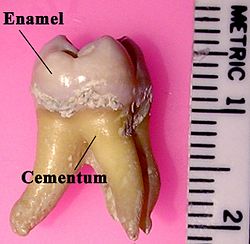Hypercementosis

Editor-In-Chief: Prab R Tumpati, MD
Obesity, Sleep & Internal medicine
Founder, WikiMD Wellnesspedia &
W8MD medical weight loss NYC and sleep center NYC
| Hypercementosis | |
|---|---|

| |
| Synonyms | Cementum hyperplasia |
| Pronounce | N/A |
| Specialty | N/A |
| Symptoms | Often asymptomatic, may cause tooth pain if associated with other conditions |
| Complications | May complicate tooth extraction |
| Onset | Usually detected in adults |
| Duration | Chronic |
| Types | N/A |
| Causes | Unknown, but associated with Paget's disease of bone, acromegaly, and hyperpituitarism |
| Risks | Bruxism, trauma, inflammation |
| Diagnosis | Dental radiography |
| Differential diagnosis | Cementoblastoma, periapical cemental dysplasia |
| Prevention | None specific |
| Treatment | Generally not required unless symptomatic |
| Medication | N/A |
| Prognosis | Good, as it is usually benign |
| Frequency | Relatively uncommon |
| Deaths | N/A |
An overview of hypercementosis, a dental condition
Hypercementosis is a dental condition characterized by the excessive formation of cementum on the roots of one or more teeth. Cementum is a calcified tissue that covers the roots of teeth and helps anchor them to the alveolar bone via the periodontal ligament.
Etiology[edit]
The exact cause of hypercementosis is not well understood, but it is believed to be associated with several factors, including:
- Inflammation or trauma to the tooth
- Paget's disease of bone
- Acromegaly
- Arthritis
- Thyroid disorders
- Idiopathic causes
Clinical Features[edit]
Hypercementosis is often asymptomatic and is usually discovered incidentally on dental radiographs. In some cases, it may cause difficulty during tooth extraction due to the increased bulk of the root.
Diagnosis[edit]
The diagnosis of hypercementosis is primarily made through radiographic examination. On an X-ray, affected teeth show an increased radiopacity at the root apex, indicating the presence of excess cementum.
Treatment[edit]
In most cases, hypercementosis does not require treatment unless it is associated with other dental issues or complicates dental procedures. If extraction is necessary, surgical intervention may be required to manage the enlarged root structure.
See Also[edit]
Ad. Transform your life with W8MD's Budget GLP-1 injections from $75


W8MD offers a medical weight loss program to lose weight in Philadelphia. Our physician-supervised medical weight loss provides:
- Weight loss injections in NYC (generic and brand names):
- Zepbound / Mounjaro, Wegovy / Ozempic, Saxenda
- Most insurances accepted or discounted self-pay rates. We will obtain insurance prior authorizations if needed.
- Generic GLP1 weight loss injections from $75 for the starting dose.
- Also offer prescription weight loss medications including Phentermine, Qsymia, Diethylpropion, Contrave etc.
NYC weight loss doctor appointmentsNYC weight loss doctor appointments
Start your NYC weight loss journey today at our NYC medical weight loss and Philadelphia medical weight loss clinics.
- Call 718-946-5500 to lose weight in NYC or for medical weight loss in Philadelphia 215-676-2334.
- Tags:NYC medical weight loss, Philadelphia lose weight Zepbound NYC, Budget GLP1 weight loss injections, Wegovy Philadelphia, Wegovy NYC, Philadelphia medical weight loss, Brookly weight loss and Wegovy NYC
|
WikiMD's Wellness Encyclopedia |
| Let Food Be Thy Medicine Medicine Thy Food - Hippocrates |
Medical Disclaimer: WikiMD is not a substitute for professional medical advice. The information on WikiMD is provided as an information resource only, may be incorrect, outdated or misleading, and is not to be used or relied on for any diagnostic or treatment purposes. Please consult your health care provider before making any healthcare decisions or for guidance about a specific medical condition. WikiMD expressly disclaims responsibility, and shall have no liability, for any damages, loss, injury, or liability whatsoever suffered as a result of your reliance on the information contained in this site. By visiting this site you agree to the foregoing terms and conditions, which may from time to time be changed or supplemented by WikiMD. If you do not agree to the foregoing terms and conditions, you should not enter or use this site. See full disclaimer.
Credits:Most images are courtesy of Wikimedia commons, and templates, categories Wikipedia, licensed under CC BY SA or similar.
Translate this page: - East Asian
中文,
日本,
한국어,
South Asian
हिन्दी,
தமிழ்,
తెలుగు,
Urdu,
ಕನ್ನಡ,
Southeast Asian
Indonesian,
Vietnamese,
Thai,
မြန်မာဘာသာ,
বাংলা
European
español,
Deutsch,
français,
Greek,
português do Brasil,
polski,
română,
русский,
Nederlands,
norsk,
svenska,
suomi,
Italian
Middle Eastern & African
عربى,
Turkish,
Persian,
Hebrew,
Afrikaans,
isiZulu,
Kiswahili,
Other
Bulgarian,
Hungarian,
Czech,
Swedish,
മലയാളം,
मराठी,
ਪੰਜਾਬੀ,
ગુજરાતી,
Portuguese,
Ukrainian